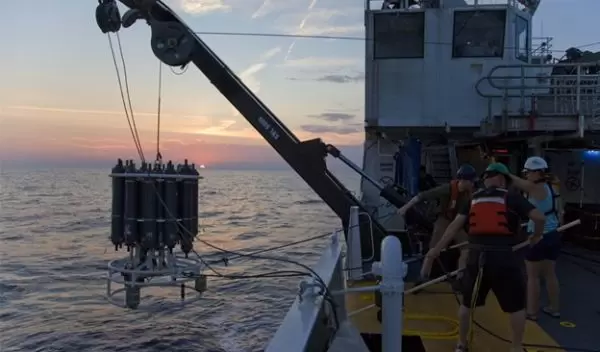
Scientists find that most nitrogen in the Gulf of Mexico comes from coastal waters
Almost all the nitrogen that fertilizes life in the open Gulf of Mexico is carried there from shallower coastal areas, U.S. National Science Foundation-funded researchers at Florida State University have found.
The work, published in Nature Communications, is crucial to understanding the food web of the Gulf's ecosystem, which is a spawning ground for several commercially valuable species of fish, including the Atlantic bluefin tuna.
"The open-ocean Gulf of Mexico is important for a lot of reasons," said Michael Stukel, a co-author of the paper and researcher at Florida State University. "It's a sort of ocean desert, with very few predators to threaten larvae, which is part of what makes it a good spawning ground for tuna and mahi-mahi. There are all kinds of other organisms that live in the open ocean as well."
The food web in the Gulf of Mexico starts with phytoplankton. Like plants on land, phytoplankton need sunlight and nutrients, including nitrogen, to grow. The researchers wanted to understand how that nitrogen is entering the Gulf.
They considered a few hypotheses. Their first idea was that the nitrogen might be coming from the deep ocean. Another was that a type of phytoplankton known as a "nitrogen fixer" was supplying the nutrient to larvae. Finally, they considered that nitrogen might be entering the open ocean from shallower areas of the coast.
By combining measurements made at sea while on research cruises with information from satellite observations and models, they found that organic matter coming from the coast is responsible for more than 90% of the nitrogen entering the open Gulf.
Large, swirling eddies act like slow-moving storms and move water from shallower areas near the coast out into the Gulf. The researchers believe that nitrogen is probably moved by these eddies.
Climate change is affecting how water near the surface of the ocean and deeper water mix. Understanding how a changing climate will affect these lateral currents is a harder question to answer, the scientists say. It's an important part of the ecosystem because the survival of larval tuna and other species that reproduce in the Gulf of Mexico is tied to currents that link coastal regions with the nutrient-poor open ocean.
Cynthia Suchman, a program director in NSF's Division of Ocean Sciences, added that "this interdisciplinary work combines biological, chemical and physical sciences to give us a better view of how the Gulf of Mexico operates as a system."


